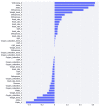Prediction and Analysis of Heart Failure Decompensation Events Based on Telemonitored Data and Artificial Intelligence Methods
- PMID: 36826544
- PMCID: PMC9958752
- DOI: 10.3390/jcdd10020048
Prediction and Analysis of Heart Failure Decompensation Events Based on Telemonitored Data and Artificial Intelligence Methods
Abstract
Cardiovascular diseases are the leading cause of death globally, taking an estimated 17.9 million lives each year. Heart failure (HF) occurs when the heart is not able to pump enough blood to satisfy metabolic needs. People diagnosed with chronic HF may suffer from cardiac decompensation events (CDEs), which cause patients' worsening. Being able to intervene before decompensation occurs is the major challenge addressed in this study. The aim of this study is to exploit available patient data to develop an artificial intelligence (AI) model capable of predicting the risk of CDEs timely and accurately. Materials and Methods: The vital variables of patients (n = 488) diagnosed with chronic heart failure were monitored between 2014 and 2022. Several supervised classification models were trained with these monitoring data to predict CDEs, using clinicians' annotations as the gold standard. Feature extraction methods were applied to identify significant variables. Results: The XGBoost classifier achieved an AUC of 0.72 in the cross-validation process and 0.69 in the testing set. The most predictive physiological variables for CAE decompensations are weight gain, oxygen saturation in the final days, and heart rate. Additionally, the answers to questionnaires on wellbeing, orthopnoea, and ankles are strongly significant predictors.
Keywords: XGBoost; decompensation; heart failure; logistic regression; machine learning; monitoring; supervised classification.
Conflict of interest statement
The authors declare no conflict of interest.
Figures






Similar articles
-
Decompensation in Critical Care: Early Prediction of Acute Heart Failure Onset.JMIR Med Inform. 2020 Aug 7;8(8):e19892. doi: 10.2196/19892. JMIR Med Inform. 2020. PMID: 32663162 Free PMC article.
-
Comparison of Machine Learning Algorithms for Predicting Hospital Readmissions and Worsening Heart Failure Events in Patients With Heart Failure With Reduced Ejection Fraction: Modeling Study.JMIR Form Res. 2023 Apr 17;7:e41775. doi: 10.2196/41775. JMIR Form Res. 2023. PMID: 37067873 Free PMC article.
-
Risk stratification in heart failure decompensation in the community: HEFESTOS score.ESC Heart Fail. 2022 Feb;9(1):606-613. doi: 10.1002/ehf2.13707. Epub 2021 Nov 22. ESC Heart Fail. 2022. PMID: 34811953 Free PMC article.
-
Machine learning-based risk prediction of malignant arrhythmia in hospitalized patients with heart failure.ESC Heart Fail. 2021 Dec;8(6):5363-5371. doi: 10.1002/ehf2.13627. Epub 2021 Sep 28. ESC Heart Fail. 2021. PMID: 34585531 Free PMC article.
-
Artificial intelligence in clinical care amidst COVID-19 pandemic: A systematic review.Comput Struct Biotechnol J. 2021;19:2833-2850. doi: 10.1016/j.csbj.2021.05.010. Epub 2021 May 7. Comput Struct Biotechnol J. 2021. PMID: 34025952 Free PMC article. Review.
Cited by
-
Clinical Predictive Modeling of Heart Failure: Domain Description, Models' Characteristics and Literature Review.Diagnostics (Basel). 2024 Feb 17;14(4):443. doi: 10.3390/diagnostics14040443. Diagnostics (Basel). 2024. PMID: 38396482 Free PMC article. Review.
-
Health Care Professionals and Data Scientists' Perspectives on a Machine Learning System to Anticipate and Manage the Risk of Decompensation From Patients With Heart Failure: Qualitative Interview Study.J Med Internet Res. 2025 Jan 20;27:e54990. doi: 10.2196/54990. J Med Internet Res. 2025. PMID: 39832170 Free PMC article.
-
Development of Machine Learning-Based Web System for Estimating Pleural Effusion Using Multi-Frequency Bioelectrical Impedance Analyses.J Cardiovasc Dev Dis. 2023 Jul 7;10(7):291. doi: 10.3390/jcdd10070291. J Cardiovasc Dev Dis. 2023. PMID: 37504547 Free PMC article.
-
Patent and Bibliometric Analysis of the Scientific Landscape of the Use of Pulse Oximeters and Their Prospects in the Field of Digital Medicine.Healthcare (Basel). 2023 Nov 20;11(22):3003. doi: 10.3390/healthcare11223003. Healthcare (Basel). 2023. PMID: 37998496 Free PMC article.
-
DigiHEALTH: Suite of Digital Solutions for Long-Term Healthy and Active Aging.Int J Environ Res Public Health. 2023 Jun 22;20(13):6200. doi: 10.3390/ijerph20136200. Int J Environ Res Public Health. 2023. PMID: 37444048 Free PMC article.
References
-
- Ponikowski P., Voors A.A., Anker S.D., Bueno H., Cleland J.G.F., Coats A.J.S., Falk V., González-Juanatey J.R., Harjola V.-P., Jankowska E.A., et al. 2016 ESC Guidelines for the diagnosis and treatment of acute and chronic heart failure: The Task Force for the diagnosis and treatment of acute and chronic heart failure of the European Society of Cardiology (ESC)Developed with the special contribution of the Heart Failure Association (HFA) of the ESC. Eur. Heart J. 2016;37:2129–2200. doi: 10.1093/eurheartj/ehw128. - DOI - PubMed
-
- Stehlik J., Schmalfuss C., Bozkurt B., Nativi-Nicolau J., Wohlfahrt P., Wegerich S., Rose K., Ray R., Schofield R., Deswal A. Continuous wearable monitoring analytics predict heart failure hospitalization: The LINK-HF multicenter study. Circ. Heart Fail. 2020;13:e006513. doi: 10.1161/CIRCHEARTFAILURE.119.006513. - DOI - PubMed
LinkOut - more resources
Full Text Sources
Other Literature Sources
Research Materials
Miscellaneous

